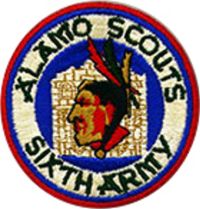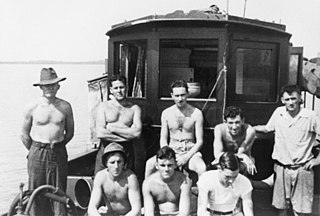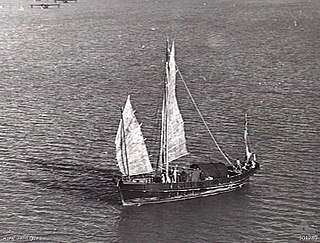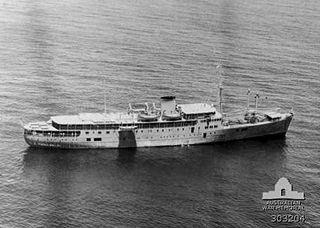Related Research Articles

USS Mugford (DD-389), a Bagley-class destroyer, was the 2nd ship of the United States Navy to be named for James Mugford, who commanded the schooner Franklin in the Continental Navy, serving through 1775.

USS Nicholas (DD/DDE-449) was a Fletcher-class destroyer of the United States Navy, serving for a total of 27 years, including through most of World War II, the Korean War, and the Vietnam War. She was the second Navy ship to be named for Major Samuel Nicholas.
Attack Force Z is a 1982 Australian-Taiwanese World War II film directed by Tim Burstall. It is loosely based on actual events and was filmed in Taiwan in 1979. It was screened at the Cannes Film Festival on 18 May 1981.

The Alamo Scouts was a reconnaissance unit of the Sixth United States Army in the Pacific Theater of Operations during World War II. The unit is best known for its role in liberating American prisoners of war (POWs) from the Japanese Cabanatuan POW camp near Cabanatuan, Nueva Ecija, Philippines in January 1945.

Z Special Unit was a joint Allied special forces unit formed during the Second World War to operate behind Japanese lines in South East Asia. Predominantly Australian, Z Special Unit was a specialist clandestine operation, direct action, long-range penetration, sabotage, and special reconnaissance unit that included British, Dutch, New Zealand, Timorese and Indonesian members, predominantly operating on Borneo and the islands of the former Dutch East Indies.
The name commando has been applied to a variety of Australian special forces and light infantry units that have been formed since 1941–42. The first Australian "commando" units were formed during the Second World War, where they mainly performed reconnaissance and long-range patrol roles during Australia's campaigns in New Guinea and Borneo, although other units such as M and Z Special Units performed more clandestine roles. These units were disbanded following the end of the war; however, in the 1950s it was realised that there was a need for such units again in the Australian forces. Today, the Australian Army possesses a number of units that perform more conventional direct-action type commando roles, as well as counter-terrorism response, long-range patrolling, and clandestine deep-penetration operations.

The New Guinea campaign of the Pacific War lasted from January 1942 until the end of the war in August 1945. During the initial phase in early 1942, the Empire of Japan invaded the Territory of New Guinea on 23 January and Territory of Papua on 21 July and overran western New Guinea beginning on 29 March. During the second phase, lasting from late 1942 until the Japanese surrender, the Allies—consisting primarily of Australian forces—cleared the Japanese first from Papua, then New Guinea, and finally from the Dutch colony.
The Catholic Church in Papua New Guinea is part of the worldwide Catholic Church, under the spiritual leadership of the Pope in Rome. Papua New Guinea has approximately two million Catholic adherents, approximately 27% of the country's total population.

The South West Pacific theatre, during World War II, was a major theatre of the war between the Allies and the Axis. It included the Philippines, the Dutch East Indies, Borneo, Australia and its mandate Territory of New Guinea and the western part of the Solomon Islands. This area was defined by the Allied powers' South West Pacific Area (SWPA) command.
Services Reconnaissance Department (SRD), also known as Special Operations Australia (SOA) and previously known as Inter-Allied Services Department (ISD), was an Australian military intelligence and special reconnaissance unit, during World War II.

The Japanese destroyer Yayoi was one of twelve Mutsuki-class destroyers built for the Imperial Japanese Navy (IJN) during the 1920s. During the Pacific War, she participated in the Battle of Wake Island in December 1941 and the occupations of New Guinea and the Solomon Islands in early 1942.

The Snake-class junks were a class of six small vessels operated by the Royal Australian Navy (RAN) to support special forces operations in 1944 and 1945. The ships were lightly armed and were used to infiltrate special forces parties and their supplies into Japanese-held territory.

The Battle of Goodenough Island, also known as Operation Drake, was a battle of the Pacific campaign of World War II. The Allies landed on Goodenough Island, Papua, and clashed with a Japanese Kaigun Rikusentai. The Japanese troops had been stranded on the island during the Battle of Milne Bay in late August 1942. "Drake Force", consisting of the Australian 2/12th Battalion and attachments, landed on the southern tip of Goodenough Island at Mud Bay and Taleba Bay on 22 October, tasked with denying the Japanese use of the island prior to the Buna campaign. Following a short but intense fight, the Japanese forces withdrew to Fergusson Island on 27 October. After the battle, Goodenough Island was developed into a major Allied base for operations later in the war.

HMAS HDML 1321, also known as Rushcutter was a 58-ton Harbour Defence Motor Launch (HMDL) of the Royal Australian Navy (RAN). Built by Purdon & Featherstone, Battery Point, Hobart, Tasmania and commissioned into the RAN on 11 November 1943, being the first Australian-built HDML to be commissioned and the last HDML in RAN service. She was assigned to Z Special Unit and delivered commandos for the 1945 ill-fated raid on Muschu Island. She was later reclassified as a Seaward Defence Boat and put into reserve after the war. She was recommissioned as HMAS Rushcutter in 1953 and used as an unarmed training vessel for the Royal Australian Naval Reserve and Australian Navy Cadets until 1970. Paid off in August 1971, she was converted to pleasure craft MV Rushcutter and is now based in Darwin.

Don Isidro, delivered in 1939, was the second and larger of two Krupp built motor ships of De La Rama Steamship Company, Iloilo, Philippines in inter-island service. The ship was under charter by the United States Army as a transport during the Japanese invasion of the Philippines. As defending forces became cut off from supply by the Japanese blockade Don Isidro was one of eight ships, only three of which were successful, known to make an attempt to run the blockade. In that attempt, under her captain Rafael J. Cisneros, Don Isidro became involved in the 19 February Japanese attack on Darwin, Australia where, though not in the port, she was strafed, bombed and left off Bathurst Island burning with all lifeboats destroyed. The captain attempted to make land when she grounded about three miles off Melville Island to which survivors swam. Of the sixty-seven crew and sixteen soldiers aboard eleven of the crew and one soldier were killed or missing. Survivors were rescued by HMAS Warrnambool, taken to Darwin, treated at the hospital and then awaited orders at the 147th Field Artillery camp.

Operation Copper was carried out by the Allied commando unit Z Special Unit, during World War II. The objective of the mission was to investigate the Japanese defences on Muschu Island, capture a Japanese officer for interrogation and discover the location of two naval guns on the island that covered the approaches to Wewak Harbour. Eight commandos were landed as part of the operation; only one survived.

The Japanese occupation of the Solomon Islands was the period in the history of Solomon Islands between 1942 and 1945 when Imperial Japanese forces occupied Solomon Islands during World War II.
Ben Hall is an Australian actor. He is known for his roles in Australian television series which began with his role as Finton Kelly in the Showcase drama Devil's Playground. From 2016 until 2022, Hall played the role of Ned Willis in the soap opera Neighbours. In 2023, Hall filmed the role of Mark Waugh in the Nine Network television series, Warnie.
The Guns of Muschu is an upcoming film to be directed by Matthew Holmes from a screenplay by Tom Broadhurst and Jack Brislee. The film, an adaptation of the novel of the same name, will star Australian actor Ben Hall in the leading role of Mick Dennis.
Jordan Fraser-Trumble is an Australian film, television and stage actor. He has appeared in the films The Legend of Ben Hall (2016), West of Sunshine (2017), The Cost (2022) and the upcoming Freelance.
References
- ↑ "The Guns of Muschu". Allen & Unwin. Retrieved 11 August 2024.
- ↑ "The Guns of Muschu / Don Dennis". National Library of Australia . Retrieved 11 August 2024.
- ↑ "Pacific World War II Reviews". Pacific Wrecks. 13 July 2024. Retrieved 11 August 2024.
- ↑ "Guns of Muschu". ABC . 24 September 2006. Retrieved 11 August 2024.
- ↑ "Cast Assembled for 'The Guns of Muschu' Australian Wartime Survival Film". Variety . 23 April 2024. Retrieved 11 August 2024.
- ↑ "Matthew Holmes eyes FNQ shoot for WW2 film 'The Guns of Muschu' starring Ben Hall". Inside Film . 23 April 2024. Retrieved 11 August 2024.